
DunavNET – agroNET
ID: 4342
May 30, 2022
Artificial intelligence-based platform for optimised cultivation and supply chain transparency.
ID: 4493
September 21, 2022
Fauna Smart Technologies is developing technologies to empower intelligent farming and restore the equilibrium in agricultural ecosystems, based on expertise in horticulture, crop protection and food security. The company offers a range of science-based and data-driven services that address the challenges faced by farmers on a daily basis, and facilitates safe transition from traditional to biological farming practices in line with sustainable values.
Fauna was founded in 2019 and is located in Copenhagen, Denmark, with a multicultural and multidisciplinary team of 12 dedicated scientists and engineers that are on a collective journey to transform the future of agriculture to provide better food for better health. At the core of the solution, both as users and as customers, are the farmers. Nonetheless, Fauna is also serving the needs of further actors in the agricultural ecosystem in terms of R&D companies and digitalisation advisors.
The solution offered by Fauna is a pest and disease management platform for open and closed field systems. Based on a range of services which cover 1) plant immunity detection, 2) pest DNA identification, and 3) satellite earth observation. The platform uses a holistic approach and further provides science-driven and customized insights for farmers when it comes to product selection: when to spray, what to spray and how much. These user-friendly instructions are designed to help farmers transition to greener, healthier and more efficient farming practices, in line with the newest EU regulations and strategies like GreenDeal, Farm2Fork and Biodiversity Strategy 2030.

Fauna is developing the underlying technologies leveraged by the platform solution and the services to facilitate the restoration of biodiversity and natural plant processes. They do so by enabling farmers to keep pathogenic fauna below economic threshold level, where the risk of yield damage caused by pest and disease is kept at a minimum. Basically, Fauna is using digitalisation as an enabler to accelerate the transition towards greener agricultural ecosystems, healthy for us as consumers, and healthy for the planet.

The incentive of Fauna to develop the IoT solution derives from a global concern for the future of agriculture as food supplying sector. The sector at present is under pressure from ever-accelerating challenges posed by the changing needs of our planet and the expectations of regulators, consumers and food processors. The farmers are held victim, having to balance their business with a range of challenges to cope with climate change, soil erosion and biodiversity loss, to meet rising demands for more quality food, to satisfy consumers’ changing tastes in food and concerns about how it is produced and to manage pests and diseases to protect their yield.
We are facing a global food crisis, and agriculture, as we know it today, will not be able to keep up with the needs of the 21st century. By 2050, almost ten billion people will live on Earth and 70% more food will be needed to feed the growing population [1].
This, combined with ongoing environmental concerns, climate change and disruption of biodiversity, poses a dilemma about future food availability and agricultural productivity. On top of this, plant diseases and pests are continuously mining the efforts of farmers to succeed in providing quality food. In fact, plant pests and diseases cause an annual worldwide crop loss of $220 billion, and are the biggest problem in every crop. The intensification of agriculture and excessive agrochemical use has allowed for resistant phytopathogenic organisms to thrive, and one consequence is that 36.5% of all crops produced yearly are destroyed by insect pests, diseases and climatic stress.
Farmers are lacking the knowledge to find the solutions that are most optimal for productivity and also environmentally and economically viable, and they need tools to support them in the decision-making process to select and use the solutions. Being just one day late in taking action against pests and disease can result in up to 3% lower yields and up to 5% less revenue. The biggest determinant to this is indeed the lack of knowledge and decision support tools: when is the right time to do what? The right time to take action to fight pests and diseases – and what action? The right time to use pesticides – and what type and amount of pesticides? The right time to stop – and what to do then to protect the quality of the crop?
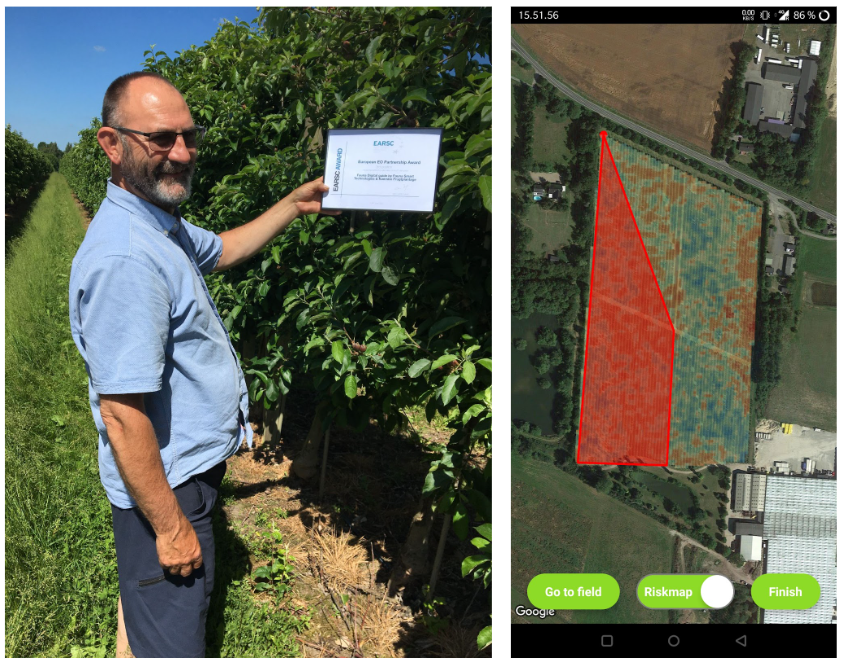
Although a variety of technological solutions are available today that are able to collect and deliver significant amounts of data on agricultural practices, only a minority is capable of doing it on the premise of the farmer. They find themselves overwhelmed by the complexity of the available solutions, non-transparent technology and intricate data that rarely seems applicable for them to take any action.
“The world is pretty much IoT, but we need to know what the valuable information for a farmer is.”
Dragana Vukasinovic, CEO and Founder at Fauna Smart Technologies
Believing that successful solutions are shaped from a bottom-up approach, Fauna started to work in direct collaboration with farmers to develop a user-friendly solution. Information of value for the individual user needs to be extracted from the big data, and the information needs to be complemented with instructions for the action needed. Information and instructions must be real-time and simple to understand, and the technology easy to use. Fauna’s platform solution was conceptualised in 2019, and the team has since then been working to continuously enhance the capabilities of both the software and the hardware, as well as refining the services in several iterations. As crop protection scientists, Fauna strives to solve the pains of farmers and empower biodiversity by using scientific approach. They are leveraging life science as an interface to connect biology and technology in order to explore the complexities in agricultural ecosystems. This facilitates an assessment of the interactions between diverse crops, soil types, environmental conditions and specific pests, diseases and climatic stress, as well as how the yield is susceptible on various levels such as DNA, RNA, metabolism, biochemistry etc. Although the solution is not yet launched commercially, it is being deployed in prototype demonstrations and pilots worldwide.
Regulatory processes are disrupting the agricultural sector at present. The European Union (EU) has committed to setting policies that support a European ecological transition and at the same time promote a global transition to sustainable agri-food systems [2]. By addressing the environmental challenges of conventional farming practices and optimising primary food production, forecasts are that up to 50% of CO2 emissions can be reduced in the agricultural domain. Therefore, stricter regulatory requirements are imposed by the EU that continuously pushes the transition towards greener practices. A new directive that is banning the use of many conventional chemical pesticides has played in favour of alternative biological pesticides and has become a main driver for the farmers to transition.
The damaging impacts of chemical pesticides on human health and biodiversity are global, and the directives are, therefore, a needed disruption. It obliges more than 10.5 million farmers in the EU to transition from chemical pesticides to biological pesticides. However, this is a difficult transition because bio-pesticides can be on average five times more expensive and because they work differently than conventional chemical pesticides. Bio-pesticides are based also on living organisms, which means that application is less targeted and effects are often delayed by several days. With this transition, farmers are thereby facing a huge challenge on how to minimise the risk of pest and disease while stabilising their yield and ensuring a viable return on investment. A lack of knowledge about the usage of bio-pesticides, combined with the lack of a financial incentive, breeds risk aversion among the farmers which is slowing down the transition.
“The farmer needs to be represented with a simple solution: when to do what and how to minimise the risk and produce greener yield. Because for a farmer, it is business. He needs to make this a viable business so he can feed his family.”
Dragana Vukasinovic, CEO and Founder at Fauna Smart Technologies
To help farmers comply with the regulatory requirements, Fauna is building their solution upon the concept of Integrated Pest Management (IPM) with the mission to maintain equilibrium between the different species within the agricultural ecosystem using a holistic approach. The key of IPM is to bring as much diversity as possible while avoiding the risk of pests, diseases or weeds dominating the whole system. IPM involves monitoring and prediction of pest outbreaks, as well as decision support for the use of pesticides. It enables (bio)-pesticides to be used only when pests reach the economic threshold level, i.e. when pests may cause economic injuries to plants. Hence, integrated into Fauna’s solution, the IPM concept reduces the use of pesticides to instances where plants have a need and farmers have an economic incentive for using them.
Fauna supports the regulations and strives to accelerate the sustainable transition of the agricultural domain and to prevent any practices that jeopardise human health and the environment. By providing technological solutions that help and enable farmers to use pesticides that work together with nature and promote biodiversity rather than destroying it, Fauna takes a lead role to drive the much-needed changes.
“To make that change happen, we use diverse technologies. And this is where IoT really fits in perfectly.”
Dragana Vukasinovic, CEO and Founder at Fauna Smart Technologies
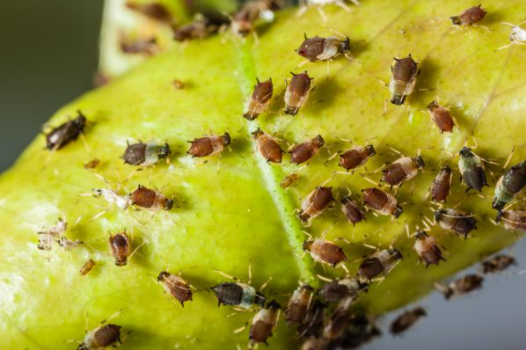
Fauna’s IoT solution covers a platform for the management of pest and disease and a range of integrated services that facilitate customised data insights and actionable instructions. The services include:
Immunity as a Service. Empowers farmers to perform measurements on the immune system of plants. This enables an assessment of whether plants are capable to suppress pests and diseases below economic threshold level, or not. Also, platform provides an option to help the plant to fight off pests and diseases externally using (bio)pesticides.
To perform the measurement, Fauna is developing the ‘plant immunity test’ that relies on an easy-to-use lab-on-paper technology very similar to the technology of, for example, pregnancy tests and COVID-19 tests. This test can detect immunity through the molecular data of the plant, which can be extracted from the liquid of a few mashed leaves. The plant liquid is then dropped onto the test area, and within a short period of time, it is indicated in the response area whether immunity is active or not active. If immunity is active, the plants can defend themselves against potential pests and diseases. If immunity is not active, action from the farmer is required and (bio)pesticides may be needed to protect the yield. This service is used primarily in controlled environments and closed field systems such as greenhouse production.

DNA as a Service. Enables farmers to tailor crop protection strategies based on the DNA of the pest itself.
Different insects need different handling strategies and different (bio)pesticides and bio-control strategies. For this reason, farmers need to be able to identify the species when active pest is detected in their crops. However, many insect species look morphologically (phenotypically) the same (cryptic species)– just like twins in the human world – but they show different susceptibility to different pesticides (we reveal this by testing their DNA). One example is the small sap-sucking insect called aphid. Aphids are famous with their groups of cryptic species they have a fast reproductive rate and in only 3-4 days they can cause high economic damages to crops. Hence, to effectively defeat aphid-pests, identification of their populations are needed.
DNA testing is needed to determine the exact species of insects, and Fauna has developed molecular markers, and the overall method (from farm to lab), that enables the identification of a particular sequence of DNA in a pool of unknown DNA. This service is applicable both in open and closed field systems.
Satellites as a Service. Enables Early Warning Prediction and Prevention of pests and diseases through EO. It is for the open field systems.
Satellites conduct field inspections to identify and monitor potential risk of pests and diseases, pest presence and ecosystem changes in real time. Visuals are captured of the entire canopy and single leaves, and via image recognition and feature matching, the software can detect potential symptoms and/or active pests and diseases. This service is used in open field systems.
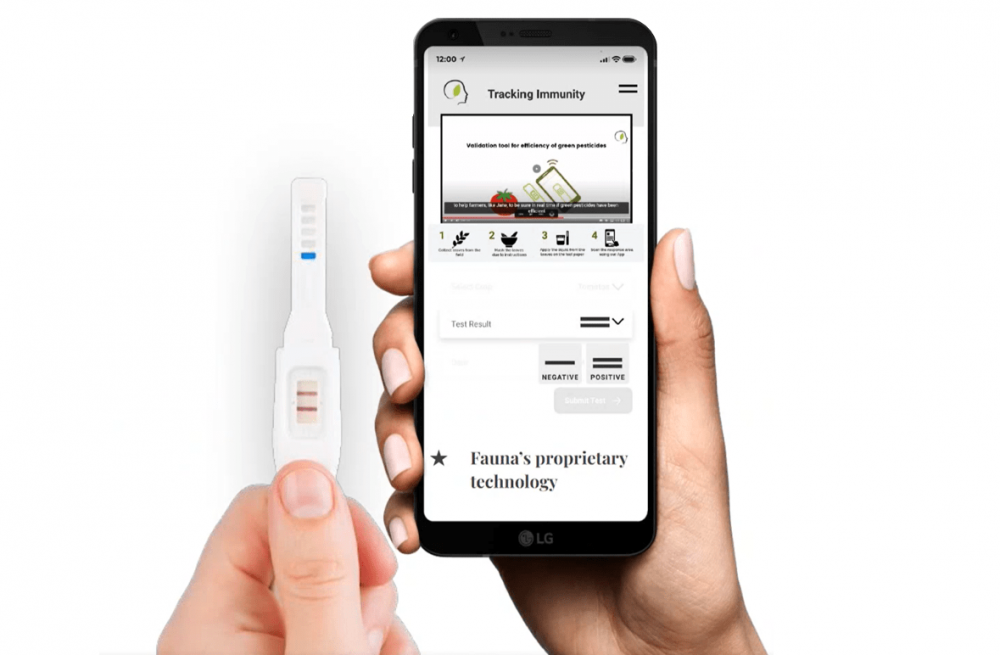
The various services can be extended with different hardware components, such as in-field sensors, meteorological stations and actuator systems, to enrich data input and/or enable autonomy in operational systems. All hardware components are compatible with third-party solutions to facilitate interoperability and potential synergies to flourish. Fauna does, however, strive to offer a solution that is based on simplified, minimum quantity hardware, both to decrease the complexity of usage and to decrease the environmental footprint that technological hardware leaves behind. With their services, they are instead pushing the phenomenon of paper based technologies.
“I think that in future there will not be conventional labs with huge facilities and huge equipment, but mini labs made of paper.“
Dragana Vukasinovic, CEO and Founder at Fauna Smart Technologies
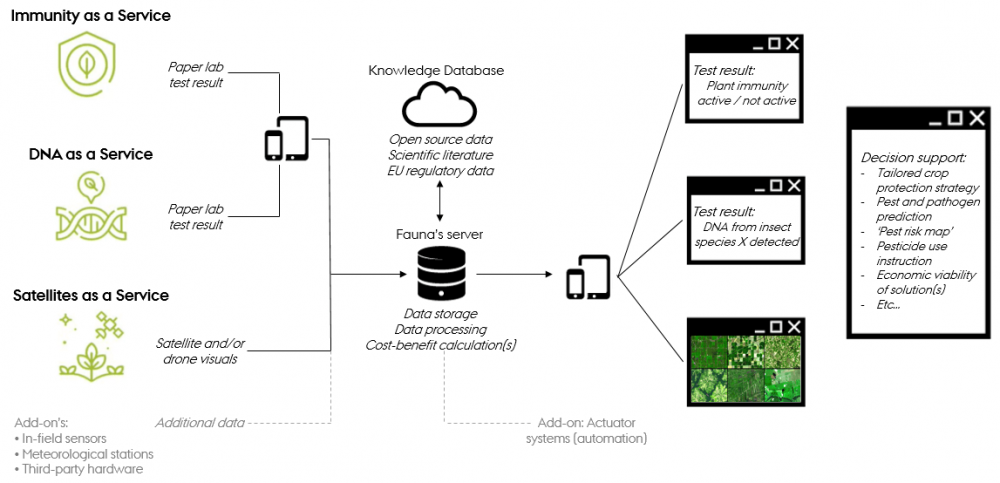
Fauna has developed The Knowledge Database as the foundation for all services. This database is the core of the platform from where solutions are being sourced for the farmers in terms of crop status insights, practice guidance, decision support and instructions in real time and on premise.
“The common denominator for all these technologies is The Knowledge Database that has been designed with farmers and for farmers.”
Dragana Vukasinovic, CEO and Founder at Fauna Smart Technologies
The database gathers extensive scientific literature from cultivation research and agricultural know-how from experienced farmers, containing all available information on sustainable agricultural practices. The database data is coupled with open source data and the input data provided by the farmers. All this data is processed by the software of the platform, performing analytics and running algorithms for a cost-benefit analysis to identify optimal solutions and generate tailored insights and instruction. Contents of the Knowledge Database are based on the latest EU regulations to support the farmers’ transition to more sustainable and green practices while achieving cost benefits. From the Knowledge Database, farmers can extract generic information that promotes both organic, biological and regenerative farming, and sustainable pest control and IPM in general, such as:
A dedicated application provides access to the Knowledge Database and serves as a user interface for all inflow and outflow streams of information. From the Knowledge Database, farmers can also extract more explicit information and instructions that are generated based on the data input from a specific service, such as:
Immunity as a Service: Via the application, the farmer can access instructions on when, what, why and how to protect the plants if immunity is tested not active. Farmers are hereby enabled to optimally protect their yield and avoid using (bio)pesticides on plants that do not need them.
DNA as a Service: Via the application, the farmer can access information on the specific type of pest and customised strategies for how to suppress it and avoid it from spreading. The software performs sequence analysis and one-to-many calculations that provide insight into the extent and risk of the pest. Species are defined, and potential rate of growth and distribution is calculated, providing an indication of the pest presence being for example 20% of species A and 80% of species B.
Satellites as a Service: Via the application, the farmer can access GPS location of the potential risk and for the pest affected parts of the field, along with the precise (bio)pesticide dosage calculation for the infected areas and areas at risk. The thorough in-field investigations enable real-time mapping of pest risk levels. Based on observed pest presence, its distribution and other detected environmental and meteorological factors, the software generates a ‘Pest Risk Map’ that displays zones within a field, classifying them as healthy, at risk and high risk. For each of these zones, the software proposes a range of environmentally friendly solutions for the farmer to redeem the risk. For each solution proposed, a cost-benefit calculation is included, giving the farmer an accurate estimate of the economic viability of the decision.
The development of Fauna’s IoT solution is a contribution to overcoming the most profound challenges faced by conventional agriculture at present. By supporting and enabling individual farmers, the solution accelerates the transitioning of the sector into – not only a more sustainable – but also a smarter sector with intelligent farming practices that are better prepared to respond to the needs of our planet and future generations, as well as to meet the expectations of regulators, consumers and food processors.
It is indisputable that bio-pesticides are associated with higher environmental safety, as they are composed of biodegradable compounds. They are effective in small quantities and have a lower rate of resistance development compared to chemical pesticides. Over and above, bio-pesticides can be used in integrated strategies with conventional pesticides working together to increase crop yields and extend application timing. Hence, when applied ‘correctly’ (i.e. correct timing, correct amount, correct mix, correct ratio, correct recipient object etc.), they are indeed key for the transition towards more sustainable agriculture. Fauna’s solution helps farmers to understand and act ‘correctly’, manoeuvring productivity of practices with agronomic durability, economic feasibility and environmental friendliness. By providing the insights needed to phase out conventional pesticides, decision support generated in alignment with specific situations of individual farmers, and instructions for taking action, the platform directs the farmer towards the most environmentally and economically optimal solution(s).
“By multiplying values of biology and technology we are creating the system approach: from Universe to DNA and back while we stop to restore the broken parts of the ecosystem.”
Dragana Vukasinovic, CEO and Founder at Fauna Smart Technologies
To Fauna, the platform is a vital underpinning of the service portfolio and the revenue streams of the company. Monetary outcomes are harvested through a continuous profit mechanism that is based on subscriptions for platform access and complemented by the direct sales of services. The value of the business increases concurrently with the content of the Knowledge Database, offering the potential for Fauna to monetise on further revenue models in the future: an affiliate model would, for example, allow Fauna to establish an e-commerce relationship with agricultural merchants that agrees to pay for being advertised to farmers in the Knowledge Database or a data leverage model that would allow Fauna to sell customer data to third-party companies for research and segmentation purposes.

For end-users of the solution, the direct value is intelligent support to optimise farming practices. Essentially, the platform and complementary services provide farmers with all the knowledge, guidance and solutions they need to optimise crop quality, maximise yield and maintain a high level of environmental friendliness with economic viability, promoting both human health and biodiversity. This value proposition derives from the following outcomes generated by the solution:
For additional customers of the solution, in terms of agricultural digitalisation advisors and agricultural R&D companies, the outcomes gained from the solution are derived effects from the value proposition redeemed by the farmers. Advisors, for whom Fauna’s services can be incorporated into their own service portfolio as an added value offering, benefit from a decrease in the time they spend visiting fields, and R&D companies, for whom data gathering is an essential value stream, benefit from access to the Knowledge Database and thereby the input data provided by farmers. The insights on pest and disease occurrences and on effects of various protection strategies facilitate further research and development of alternatives to pesticides and refine plant immunity boosters to cultivate plant immunity on different threshold levels.
Yet another derived effect of the solution that is valuable for the agricultural ecosystem actors is the automatically generated Field Book:
“One very valuable outcome from our Knowledge Database is a Field Book. …It is like a certification when transitioning from conventional to organic.”
Atijana Mitic, COO at Fauna Smart Technologies
Every action in the crop production process is recorded in a Digital Field Book, offering documentation for all actions made by the farmer during the usage of the solution. For R&D companies this provides a comprehensive and reliable full-scale data set, and for advisors and farmers, it provides proof that practices are transitioning towards becoming more sustainable and that they are executed in line with the EU regulations. Having this documentation offers a development track record, and it provides the farmer eligibility for receiving subsidies that are offered by the government to support farmers in becoming greener.
Since Fauna introduced the idea of leveraging IoT technology to manage agricultural biology in terms of pest and disease management, the solution has undergone many iterations, and just as many valuable learnings have transpired. Some of them with potentially transmissible value for other actors in the IoT ecosystem.
Human knowledge and IoT technology are crucial leverages to enable the transition towards more efficient and regenerative farming practices, thus facilitating restoration of biodiversity. However, to conduct business based on this premise can be a harsh encounter that brings along philanthropic reconsiderations in a profit focused world. This is one of the many learnings attained by Fauna, who stress that although the resistance of the market to adopt the solution has been discouraging at times, they would not have done without it because overcoming such challenges is what makes the business and the individuals within it grow.
“It is complex system innovation…We should be doing this, and as humanity, we have the capacity. It is a challenge, but it is a really great growth process.”
Dragana Vukasinovic, CEO and Founder at Fauna Smart Technologies
Fauna finds that no matter how novel, innovative and complex technologies a solution deploys, and no matter how massive potential it has to benefit and redefine the entire ecosystems – the only how that matters to the end-user is how to use it. Hence, the success of a solution relies on the level of simplicity, intuitiveness and user-friendliness that the IoT innovator is able to incorporate and present in the value proposition.
Fauna considers a number of points to be vital for the success of their IoT solution so far. Taking departure in the journey of development and demonstration, these points are compiled into a list of recommendations below:
1. Embrace diversity
Diversity can facilitate valuable learnings, broaden intellectual horizons and magnify collaborative outcomes. However, for diversity to thrive in corporate environments, people must be adaptable.
“You need to enjoy the diversity, and you need to embrace this journey of constant changes.”
Atijana Mitic, COO at Fauna Smart Technologies
For Fauna, internal adaptability has been essential in aligning views and communication in the interplay between the diverse team of scientists, engineers and technologists, and external adaptability has been essential in finding trusted partners that complement each other and are willing to grow with the company through a changeable journey.
2. Take value creation to a societal level
Societies should be organised based on natural principles and in alignment with nature, but as the human race, we have done it the other way around, which has triggered the challenges of climatic stress and resource scarcity we are currently facing. As humans, we are capable of addressing these challenges as well, and Fauna considers it our responsibility to do so. They recommend IoT innovators to develop solutions that create value not only for the user but for society.
“It is always about finding the best solution that is economically and environmentally friendly. It cannot be just profit, it needs to be good for the planet as well.”
Dragana Vukasinovic, CEO and Founder at Fauna Smart Technologies
3. Let passion set the team
The team is the paramount determinant for any company. According to Fauna, finding dedicated employees, who are passionate about the business and what they do, is the recipe for success. For the team behind Fauna, it is a shared passion to solve the challenges faced by farmers and facilitate the agricultural transition from traditional to biological farming practices in line with sustainable values that have been the fundamental driver for the achievements of the company.
“We think collectively that nothing is impossible… That brings our vision to life.”
Atijana Mitic, COO at Fauna Smart Technologies
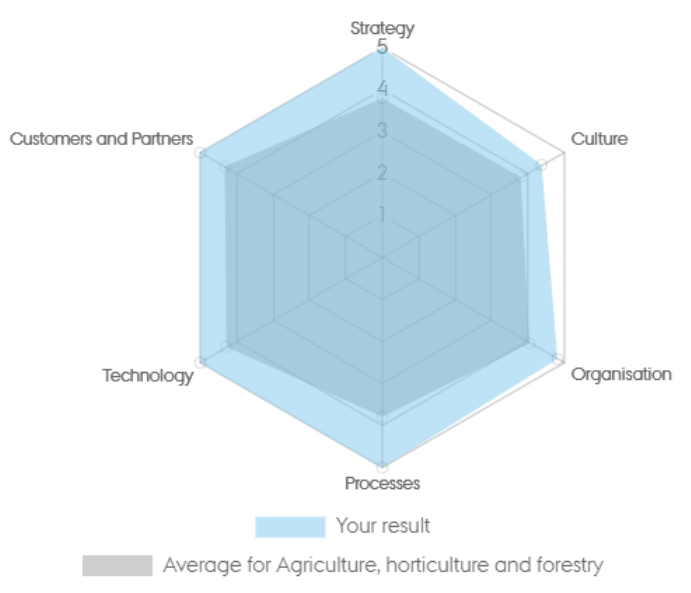
Fauna assumes a high level of digital maturity with an overall score of 4.87. The score indicates that the digital capabilities of the company are vastly mature, and that they perform above average for the agriculture, horticulture and forestry sector.
The Digital Maturity Assessment Tool is copyrighted by Associate Professor and PhD Annabeth Aagaard, Director at the Interdisciplinary Centre for Digital Business Development, Aarhus University. To get the digital maturity of your company mapped out, click here.
[1] https://www.syngenta.com/en/innovation-agriculture/challenges-modern-agriculture
[3] LD50: Acute Toxicity is measures by the median lethal dose (LD50). LD50 is defined as the dose of a test substance that is lethal for 50% of the animals in a dose group.

Copyright notice: © 2020 – 2023 EU-IoT Consortium.
This material was produced as part of the EU-IoT project, grant ID 956671, and is funded by the Horizon 2020 Framework Programme under topic ID ICT-56-2020.
EU-IoT is the European IoT Hub. The EU-IoT project works towards growing a sustainable and comprehensive ecosystem for Next Generation Internet of Things.
Source of origin: Information to document this use case originates from the H2020 call: ICT-33-2019 Startup Europe for Growth and Innovation Radar (IA); Project Startup3 871709; Period: 01-01-2020 to 31-12-2021; EC contribution 1.3 mil. EUR.
